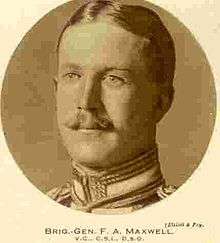Francis Aylmer Maxwell
| Francis Aylmer Maxwell | |
|---|---|
 | |
| Born |
7 September 1871 Guildford, England |
| Died |
21 September 1917 (aged 46) Ypres, Belgium |
| Buried at | Ypres Reservoir Cemetery |
| Allegiance | United Kingdom |
| Service/branch | British Indian Army |
| Years of service | 1893–1917 † |
| Rank | Brigadier General |
| Unit | Indian Staff Corps |
| Commands held |
27th Infantry Brigade 12th Battalion Middlesex Regiment |
| Battles/wars |
Chitral Expedition Tirah Campaign Second Boer War First World War |
| Awards |
Victoria Cross Companion of the Order of the Star of India Distinguished Service Order & Bar Mentioned in Despatches |
Brigadier General Francis Aylmer Maxwell, VC, CSI, DSO & Bar (7 September 1871 – 21 September 1917) was a British Army officer in the Second Boer War and First World War. He was also a recipient of the Victoria Cross (VC), the highest award for gallantry in the face of the enemy that can be awarded to British and Commonwealth forces.
Early life and military career
Maxwell was commissioned a second lieutenant in the Sussex Regiment on 7 November 1891 and promoted to lieutenant on 24 November 1893. He transferred to the Indian Staff Corps, Indian Army, and took part in the Chitral Expedition in 1895 with the Queen's Own Corps of Guides. In the following years he served on the North-West Frontier of India, and took part in the Tirah Campaign 1897-98 under Sir William Lockhart, to whom he was Aide-de-camp. He was appointed a Companion of the Distinguished Service Order (DSO) for his services.[1]
Second Boer War
Maxwell was attached to Roberts's Light Horse during the Second Boer War 1899-1900. By early March 1900 the British had captured the two capital cities of the Boer republics, and the war entered a new face with a Boer guerrilla campaign to hit the British supply and communication lines. The first engagement of this new form of warfare was at Sanna's Post on 31 March where 1,500 Boers under the command of Christiaan De Wet attacked Bloemfontein's waterworks about 37 kilometres (23 mi) east of the city, and ambushed a heavily escorted convoy, which caused 155 British casualties and the capture of seven guns, 117 wagons, and 428 British troops.[2]
Victoria Cross

Maxwell was 28 years old, and a lieutenant attached to Roberts's Light Horse during the Second Boer War when the following deed took place for which he was awarded the VC:
On 31 March 1900 at Sanna's Post (aka Korn Spruit), South Africa,
Lieutenant Maxwell was one of three Officers not belonging to "Q" Battery, Royal Horse Artillery, specially mentioned by Lord Roberts as having shown the greatest gallantry, and disregard of danger, in carrying out the self-imposed duty of saving the guns of that Battery during the affair at Korn Spruit on 31st March, 1900.This Officer went out on five different occasions and assisted, to bring in two guns and three limbers, one of which he Captain Humphreys, and some Gunners, dragged in by hand. He also went out with Captain Humphreys and Lieutenant Stirling to try to get the last gun in, and remained there till the attempt was abandoned.
During a previous Campaign (the Chitral Expedition of 1895) Lieutenant Maxwell displayed gallantry in the removal of the body of Lieutenant-Colonel F. D. Battye, Corps of Guides, under fire, for which, though recommended, he received no reward.[3]
Major Edmund Phipps-Hornby, Sergeant Charles Parker, Gunner Isaac Lodge and Driver Horace Glasock also earned the Victoria Cross in this action.
Later service in South Africa
Maxwell was promoted to captain on 10 July 1901. He was appointed Aide-de-camp to Lord Kitchener, Commander-in-Chief of the Forces in South Africa. Following the end of hostilities in early June 1902, he left Cape Town on board the SS Orotava together with Lord Kitchener,[4] and arrived at Southampton the next month.[5] He received a brevet promotion to major on 22 August 1902.
First World War
As commander of the 12th Battalion of the Middlesex Regiment, and later of the 27th Brigade, Maxwell came to be regarded as one of the finest combat commanders serving in the British Army on the Western Front. He was an aggressive commander who was also both an original thinker and popular with his men.[6]
Despite his rank, Maxwell was frequently at the front line. He was killed in action, shot by a German sniper, during the Battle of the Menin Road Ridge on 21 September 1917.[6] He is buried in Ypres Reservoir Commonwealth War Graves Commission Cemetery.[7] The gravestone inscription states: "An ideal soldier and a very perfect gentleman beloved by all his men."
General Maxwell is commemorated with a plaque in St. Giles Cathedral on the Royal Mile in Edinburgh, Scotland.[8] Maxwell's medals are now held in the Lord Ashcroft collection after sale at auction.[9] His wife, Charlotte Maxwell, published a volume of his edited letters in 1921.[10]
-
Gravestone in 2015 in Ypres Reservoir Cemetery
-

Memorial in St. Giles Cathedral
-

Earlier photograph of Maxwell's CWGC gravestone
References
- ↑ Hart′s Army list, 1903
- ↑ N. G. Speed, Born to Fight
- ↑ The London Gazette: no. 27292. p. 1649. 8 March 1901. Retrieved 30 November 2009.
- ↑ "The Army in South Africa - Troops returning home". The Times (36804). London. 26 June 1902. p. 10.
- ↑ "Lord Kitchener′s return". The Times (36819). London. 14 July 1902. p. 6.
- 1 2 John (1 June 2002). Who's Who in World War I. Routledge. p. 202. ISBN 978-1-134-76752-6.
- ↑ Profile
- ↑ UK War Memorial listing for his monument in St, Giles
- ↑ Auction information
- ↑ Maxwell, Charlotte (1921). Frank Maxwell Brig. General, V.C., C.S.I., D.S.O. A Memoir and Some Letters. London: John Murray. p. 228.